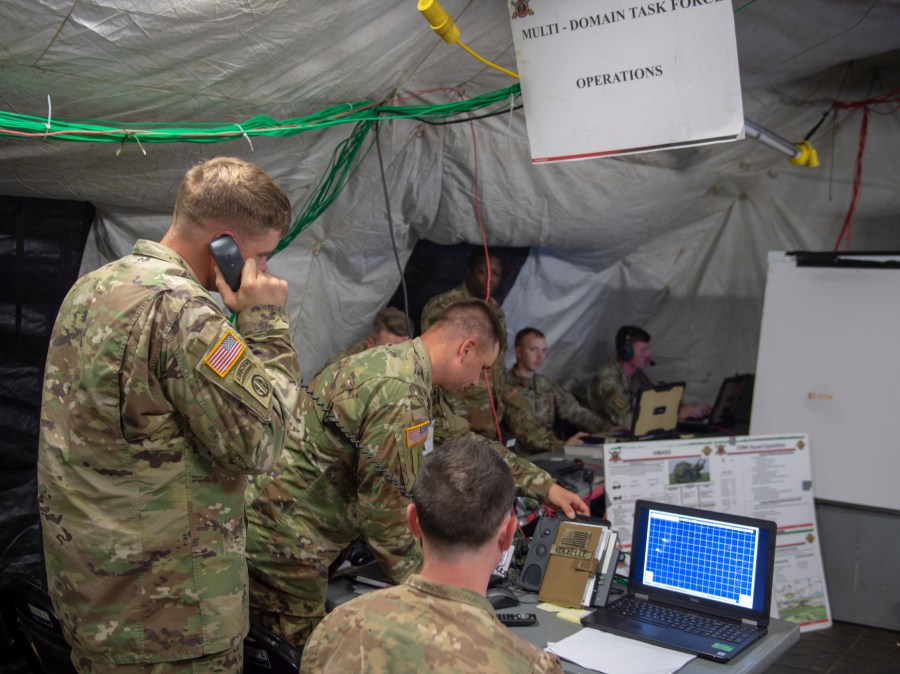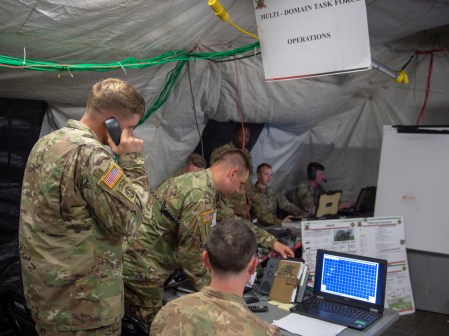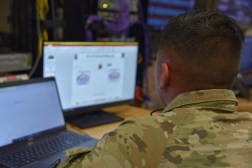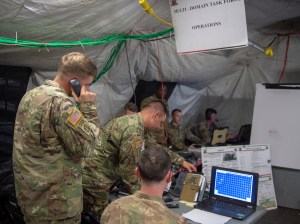Army equipping National Guard with modernized network equipment

ABERDEEN PROVING GROUND, Md. — The Army has begun equipping National Guard units with new communication and situational awareness technologies that were developed for battlefield use, but could also aid in responding to domestic disasters.
“They built capability that’s dual use. It’s built for the Title 10 mission, the warfighter, but it also can be built [and fielded] in a homeland [scenario] because of the technology,” Kenneth McNeill, chief information officer/J6 for the National Guard Bureau, told FedScoop on a recent trip to Aberdeen Proving Ground, Maryland, in late June for a demonstration of capabilities associated with the Army’s integrated tactical network.
When called to respond to a national disaster or crisis, there are local, state and federal organizations the Guard must communicate and coordinate with. As a result, there needs to be technologies that make this easier.
“You’ve got to have technology that bridges and you can talk to those civilian agencies. The PEO has played a significant role in building out capability in the past and continue to build our capabilities,” McNeill said, referring to Program Executive Office Command, Control, Communications-Tactical, which fields the Army’s network equipment.
One such situational awareness tool is the Command Post Computing Environment (CPCE), which consolidates disparate standalone systems into a single user interface.
There’s an opportunity for the Guard to put some of its applications and systems in the proverbial app store that can be used for domestic operations, said Col. Evert Hawk, the leader of the network cross-functional team assigned to Army Futures Command.
“For security operations, you need to talk to the various law enforcement agencies,” he said. That could include the FBI or other federal and local agencies. In the case of the Jan. 6, 2021, insurrection, for example, it included D.C. Metro Police and Capitol Police.
“How do all these people [who] are on their own little network siloed, how do they all get together and talk?” he said.
Eleven units and mission training centers in Pennsylvania have already received CPCE and tactical server infrastructure, with 35 more expected in fiscal 2022.
Getting cloud-based applications and equipment that have a limited physical footprint is critical to rapid response.
“Having small scalable capability that you get to a location, you pop up, you plug into the D.C. Police Department or the Park Police or the Capitol Hill Police Department, that’s tremendous,” McNeill said of dealing with a domestic crisis like the events of Jan. 6, 2021.
In addition to the domestic mission of the Guard, fielding this equipment is important from a broader Army operational and modernization perspective. If Guard units have to be mobilized to conduct missions with the active component, they should be proficient in how the systems work.
“Network modernization is an enduring mission across the total force, and we need to not only understand what the future network looks like, but we need to make sure we have the right people in the right positions to operate it,” Col. Isaac Martinez, Army National Guard chief information officer and network communications officer, said during an Army National Guard G-6 tactical communications conference in May.
Other equipment that has been or will be fielded includes handheld and small form fit Manpack radios, secure wireless technology and terrestrial transmission line-of-sight radios, among others.
The Army is also in the process of converting the first National Guard Expeditionary Signal Battalion to an Expeditionary Signal Battalion-Enhanced. Such units are primarily meant to support other units that don’t have organic communications capabilities.
As part of this conversion, there are force structure changes that take place as well as replacing legacy equipment with technology that is more capable for satellite communications.
“You’re moving them from a legacy, more stationary … kit to much more expeditionary,” Col. Shane Taylor, program manager for tactical networks at PEO C3T, said. “Much more lighter, much more expeditionary up and down … for simple, intuitive to use.”





